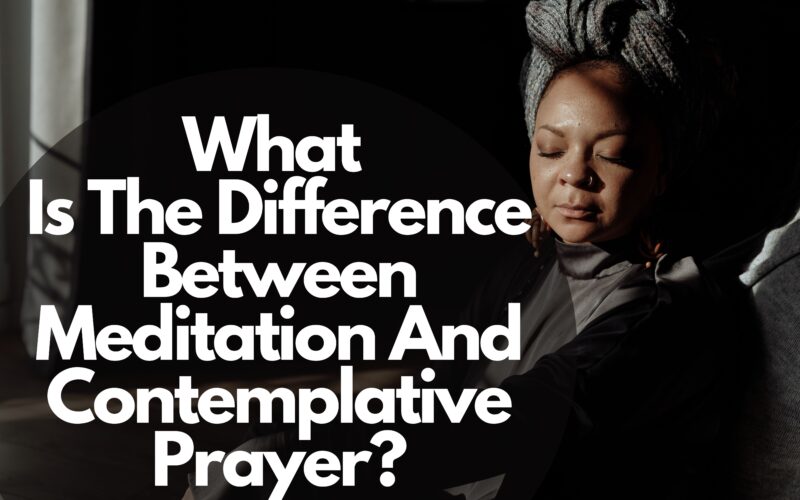Table of Contents Show
In the pursuit of inner peace and spiritual growth, many individuals explore various techniques to attain a state of mindfulness and connection with the divine or their inner selves. Two practices that often emerge in this quest are meditation and contemplative prayer.
While both involve deep introspection and a focus on spiritual awakening, they originate from distinct cultural and religious backgrounds, each carrying its own unique essence and purpose.
What Is The Difference Between Meditation And Contemplative Prayer?
In essence, the fundamental difference between meditation and contemplative prayer lies in their distinct approaches to spiritual introspection.
While meditation emphasises the practice of mindfulness and detached observation of thoughts, contemplative prayer focuses on fostering a deeper connection with the divine through prayer and reflection. It’s essential to recognise that both practices can coexist harmoniously, offering individuals unique paths towards spiritual growth and self-discovery.
Understanding Meditation
Meditation, a practice with ancient roots in Eastern philosophy and spirituality, involves training the mind to achieve a heightened sense of awareness and mindfulness. Through various techniques such as mindfulness meditation, loving-kindness meditation, or transcendental meditation, individuals aim to cultivate a sense of tranquility, emotional balance, and mental clarity
Looking Into Contemplative Prayer
On the other hand, contemplative prayer finds its origins in the Christian tradition, emphasizing silent . It involves fostering a deep, intimate connection with the divine, often through repetitive prayers, scriptural readings, and quiet contemplation. Contemplative prayer seeks to create a space for spiritual communion and a profound sense of God’s presence.
Contrasting Elements
While both meditation and contemplative prayer share the common objective of achieving spiritual growth and self-awareness, they differ significantly in their underlying principles and techniques. Meditation primarily focuses on self-awareness and detachment from the ego, while contemplative prayer centers around the connection with the divine and seeking solace in God’s presence.
Purpose And Goals
The purpose of meditation lies in achieving mental clarity, emotional stability, and a deeper understanding of oneself, fostering a sense of inner peace and mindfulness. On the other hand, contemplative prayer aims to establish a direct channel of communication with God, fostering spiritual growth, and nurturing a profound sense of faith and devotion.
Techniques And Practices
Meditation incorporates various techniques such as focused breathing, visualization, and mantra repetition, aiming to quiet the mind and achieve a state of deep concentration and awareness. Contemplative prayer, however, involves the use of repetitive prayers, sacred texts, and silence, emphasizing the cultivation of an intimate relationship with God through meditative spiritual practices.
Benefits And Effects
1. Enhanced Mental Clarity
Regular practice of contemplative prayer and meditation can improve focus, concentration, and cognitive function, leading to increased mental clarity and mindfulness.
2. Stress Reduction
Engaging in contemplative prayer and meditation has been shown to lower stress levels, promote relaxation, and alleviate symptoms of anxiety and depression, fostering a sense of inner peace and emotional stability.
3. Spiritual Growth
Contemplative practices facilitate a deeper connection with one’s spiritual self, allowing individuals to explore and strengthen their relationship with God or their chosen higher power, leading to a heightened sense of spiritual awareness and enlightenment.
4. Emotional Resilience
Through contemplative prayer and meditation, individuals can develop greater emotional resilience, enabling them to approach life’s challenges with a calmer and more balanced perspective, and fostering the ability to manage difficult emotions effectively.
5. Physical Well-being
Studies suggest that regular contemplative practices can have positive effects on physical health, such as lowering blood pressure, improving sleep quality, and boosting the immune system, ultimately promoting overall physical well-being and longevity.
The benefits of meditation include stress reduction, improved emotional well-being, enhanced focus, and increased self-awareness. Contemplative prayer, on the other hand, fosters spiritual growth, deepens one’s faith, and nurtures a sense of divine connection, leading to inner peace and a profound sense of purpose in life.
Historical And Cultural Context
Meditation traces its origins back to ancient Eastern cultures, including Hinduism and Buddhism, where it was practiced as a means of attaining enlightenment and self-realization. Contemplative prayer finds its roots in the Christian mystical tradition, with influential figures such as St. Teresa of Avila and St. John of the Cross promoting its practice for spiritual growth and union with God.
Common Misconceptions
Some misconceptions about meditation revolve around its association with religious beliefs, leading to misconstrued notions about its spiritual nature. Similarly, contemplative prayer may be misunderstood as a solitary Christian practice, often overshadowing its universal aspects of seeking spiritual connection and introspection.
Integrating Meditation And Contemplative Prayer
While originating from different cultural and religious contexts, individuals often find harmony in incorporating elements of both practices to enrich their spiritual journey. Integrating meditation techniques into contemplative prayer or infusing contemplative aspects into meditation can create a holistic approach to spiritual development and inner peace.
Modern Applications
In the contemporary world, both meditation and contemplative prayer have found widespread application beyond their traditional religious boundaries. They are incorporated in various wellness programs, therapy sessions, and mindfulness-based interventions, catering to individuals seeking mental, emotional, and spiritual well-being irrespective of their religious affiliations.
Scientific Studies And Findings
Numerous scientific studies have researched the effects of meditation on mental health, highlighting its potential in reducing stress, anxiety, and depression. Similarly, research on contemplative prayer has indicated its role in fostering emotional resilience, improving overall well-being, and enhancing individuals’ spiritual experiences and connections.
Mind-Body Connection
Both meditation and contemplative prayer have been observed to foster a strong mind-body connection, influencing individuals’ physical, emotional, and spiritual well-being. They promote a sense of harmony and balance, leading to improved overall health and a deeper understanding of the interconnectedness of the mind, body, and spirit.
Personal Experiences
Countless individuals have shared transformative personal experiences through their dedicated practice of meditation and contemplative prayer. From profound spiritual awakenings to enhanced mental clarity and emotional stability, these practices have guided many on a journey of self-discovery, spiritual growth, and profound inner peace.
Final Thoughts And Recommendations
In the pursuit of spiritual enlightenment and inner peace, the distinction between meditation and contemplative prayer remains crucial, acknowledging their unique cultural and religious origins. However, recognizing the common goal of fostering spiritual growth and self-awareness, integrating elements of both practices can lead to a holistic and enriching spiritual journey, guiding individuals toward a deeper understanding of themselves and their spiritual beliefs.
Conclusion
Understanding the nuanced disparities between meditation and contemplative prayer is vital for individuals seeking to embark on a spiritual journey.
By acknowledging their distinct methodologies and objectives, one can integrate both practices into their daily routine to foster inner peace, emotional well-being, and spiritual growth. Embracing these practices can lead to a profound sense of self-awareness and a deeper connection with the world around us.








